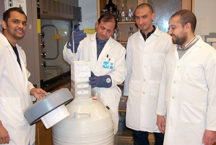Researcher taking shot at flu vaccine that's more effective, easier to make
February 6, 2013
 |
|
Purdue professor Suresh Mittal removes a sample of
cells used to grow a viral vector-based influenza vaccine with graduate
students (from left) Sai Vemula, Ahmed Hassan and Omar Amen. Mittal and his
students are working on a flu vaccine that offers broad protection against most
strains of the virus. (Purdue University photo/Jane Kovach)
|
WEST LAFAYETTE, Ind. - In the midst of an unusually deadly flu season and armed with a vaccine that only offers partial protection, a Purdue University researcher is working on a flu vaccine that overcomes the need to predict which strains will hit each year and eliminates the common causes of vaccine shortages.
This year's vaccine is 62 percent effective or "moderately" effective against the current flu strains, according to early estimates from the Centers for Disease Control and Prevention. Flu-related deaths this season have reached an epidemic level and include 45 children, according to the most recent report.
Suresh Mittal, a professor of comparative pathobiology in Purdue's College of Veterinary Medicine, is applying a method he developed for an avian flu vaccine to create a more universal seasonal flu vaccine. The vaccine's protection could persist through different strains and mutations of the influenza virus and would not be dependent on accurate predictions of the strains expected each season, he said.
"This method allows us to create a vaccine that targets core parts of the influenza virus that are found across all strains and don't mutate or change quickly," Mittal said. "It also allows us to target multiple parts of the virus, so that even if the virus adapts to one line of attack, there are others that will still work to prevent the illness."
The method uses a harmless adenovirus as a vector to deliver influenza virus genes into the body where they create a two-fold immune response of antibody and cell-based protection. The adenovirus releases the genes inside the host cells, which then create proteins that lead to the creation of antibodies and special T-cells primed to kill influenza virus and any cells infected by it.
"This method works beyond that of the current vaccine, in which the body responds to inactivated virus proteins injected into a muscle," Mittal said. "Getting the influenza virus genes inside the cells better mimics an infection and leads to a more powerful and multifaceted immune response, so we are better prepared to fend off a true infection."
Any genes important to influenza virus protection can be incorporated into the adenovirus vector, and it can be designed to expose the immune system to components from both the surface and deep within the virus. In this way the immune system can be primed to recognize portions of the virus that are the same across all strains and those that are more difficult for the virus to change as it adapts to the immune system attack, he said.
The new vaccine also has manufacturing advantages over current methods because the vector is easily grown in cell culture. The current flu vaccine depends on the growth of influenza viruses in chicken eggs.
"Sometimes the virus strains selected for the year's vaccine do not grow well in an egg and that can lead to delays or shortages of the vaccine," Mittal said. "The new method depends only on the growth of the virus vector, which we know how to grow quite well. The influenza strains we select to include have no effect on the growth or the amount of vaccine that can be made."
Mittal said vaccination is critical to save lives.
"We don't think of the flu as a killer, but it kills around 35,000 people each year," he said. "Even when the flu vaccine isn't a perfect match, it still offers the best protection. It also is important to get vaccinated to help prevent the spread of the virus to those who are too young or too sick to be vaccinated themselves."
Writer: Elizabeth K. Gardner, 765-494-2081, ekgardner@purdue.edu
Source: Suresh Mittal, 765-496-2894, mittal@purdue.edu
Related news
releases:
Purdue researcher starts work on 2009 H1N1 flu vaccine
Harmless virus may aid in knocking out deadly bird flu

